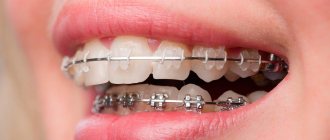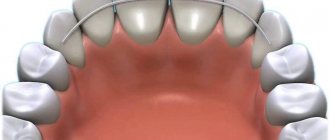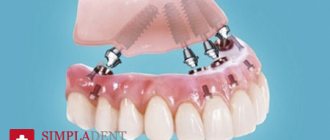28.11.2019
At the moment when the doctor informed the patient that the treatment process is over and that the braces system can be removed, teeth whitening after removing the braces becomes the most significant and important aspect for the client of the dental clinic. This is explained simply, because having received the desired result in the form of an even and beautiful row of teeth, the patient often faces unpleasant side effects in the form of stains on the tooth enamel. To get rid of such troubles, it is necessary to perform whitening so that no plaque or tartar remains on the teeth.
Is it possible to whiten teeth after braces?
It is not difficult to understand a patient who, after removing braces, suddenly discovers spots of different colors on his teeth; his desire to whiten looks quite natural. Of course, you can whiten your teeth after removing braces, but you will have to wait a little, about a month, before starting this procedure. By the way, there are also situations when a specialist recommends increasing the waiting period due to the individual characteristics of the patient’s oral cavity and the poor condition of his teeth. Whitening is based on a chemical reaction, as a result of which the released active oxygen penetrates the upper layers of the teeth and brightens them. Such an intervention is stressful, hence some pain experienced by the patient after its completion.
In any case, there is no need to rush, even if the appearance of the jaw is so smooth and beautiful because of its color. There are two important aspects that support this statement:
- during the waiting period, the enamel will be restored and will no longer be depleted and weak;
- the natural color of some areas can be restored without external aggressive intervention.
Retention stage after braces
The retention period occurs immediately after removal of the structure and other orthodontic products. After this, you need to install retention devices to maintain the result. If a person refuses this stage, a violation of occlusion may occur and the jaw will not close normally. This will cause the enamel to wear away and periodontal diseases will appear.
Retention devices and structures:
- Removable retainers. Metal plates with arcs that will be installed in such a way that the incisors are in the correct position. The product will limit their movement and also secure them in the desired position. Retainers are installed on the inside of the teeth. A person will not feel them, they will not yet be visible.
- Removable retention guards. They are made from biopolymer materials based on an impression of the incisors. The products will follow the desired shape of the dentition and hold the teeth.
- Fixed retainers. The products are placed on the inner surface of the crowns. They are fixed only with special glue. Plates with arches that will support the dentition in the desired position.
- Cast splinting retainers. They are used during the period of retention in those people who suffer from malocclusion and periodontal disease. The products are not removed, but hold the crowns tightly so that they do not move in any way.
It should be remembered that teeth should acquire a stable position after braces. It is best to adhere to certain rules so that the incisors are beautiful and even. Now you know what is put on your teeth after braces .
How to do whitening?
The teeth whitening procedure is one of the most effective and highly popular among dental patients. Its rather high cost is not the most pleasant moment, but the result obtained justifies all financial investments and costs.
When contacting a dentist with a similar problem, you can count on the following methods to solve the problem:
- hygienic cleaning with the help of which removes plaque and tartar, and also restores the natural color of the enamel;
- laser cleaning, which requires perfect cleanliness but gives excellent results;
- the use of special whitening strips that remove the yellow color of teeth and return them to their natural color.
Advantages and disadvantages of whitening
The key advantage of the whitening procedure is manifested in a person’s beautiful snow-white smile. In addition, yellow teeth are not only not very beautiful, but also not very stable, and this is not only a problem with the appearance of the teeth. Whitening makes it possible to get rid of plaque and tartar, prevents the growth of bacteria in the oral cavity, and accordingly the risk of developing caries is reduced.
However, whitening also has disadvantages, in particular the likelihood of certain complications, which are not difficult to avoid; it is necessary to visit the dentist in a timely manner to diagnose the condition of the enamel.
How and with what to properly clean braces and teeth
Once the braces are in place, a regular toothbrush won't help much. The presence of an arc or rubber bands will not allow you to remove plaque from all places on your teeth. In the first days after getting braces, teeth may hurt, and many patients may be tempted to “feel sorry for themselves” and not brush their teeth. Your teeth will stop hurting, but it will be difficult to remove leftover food. It is important to avoid such thoughts and carry out hygiene procedures in any case.
V-shaped orthodontic brush
An orthodontic V-shaped brush differs from a regular brush by having a strip of short bristles in the middle. This strip of short bristles creates a groove at the level of the part of the tooth to which the bracket will be attached, following the shape of the surface. The presence of such a gutter makes cleaning easier and improves its quality. When brushing your teeth, you should make vibrating circular movements, spending at least 10 seconds on one tooth . If you look at the end of such a brush, the outline of the bristles will be shaped like the letter V, which is why it got its name.
Mono-beam brush
A mono-beam brush is not much like a regular one. Bristles collected in one bunch are attached to the rounded working part. The use of this brush is of an auxiliary nature. This brush is designed to remove plaque from hard-to-reach places . Its dimensions allow you to remove plaque from under the arch and clean the area of the tooth located next to the braces. The movements made by the brush should look like sweeping. Light pressure on the brush is acceptable. In this case, the bristles are spread out like a fan over the surface of the tooth and help cover a large area of its surface.
Orthodontic brushes for cleaning braces
Orthodontic brushes are designed to clean inaccessible areas, such as wide interdental spaces, as well as areas under the arch of the bracket system. Interdental spaces occupy 1/3 of the entire tooth area. It is this part of the tooth that especially suffers from lack of hygiene when wearing braces. It is brushes that can efficiently clean these tooth surfaces. If your teeth are closely spaced, then you should give preference to another method of cleaning this area, for example, dental floss.
Dental floss for cleaning braces (floss or super-floss)
Dental floss is designed to clean the areas between teeth. To clean teeth with braces, regular dental floss can only be used in conjunction with thread guides, similar to ultra-thin fishing line. The thread guide will allow you to guide the dental floss under the braces.
A loop is made from the thread guide and inserted into the interdental space. Dental floss is threaded through this loop and brought out between the teeth. Considering that it is necessary to clean every interdental space, this process seems quite labor-intensive and time-consuming.
A more convenient type of thread for cleaning interdental spaces under braces is superfloss, which, unlike regular thread, does not need to be torn off from the skein; these threads are already packaged separately . One end of such a thread is dense and thin, the remaining part is loose and fibrous.
The tight end of the thread should be inserted under the arch into the interdental space, clean it, and then pull the thread out on the other side of the dentition. The more fibrous part of the superfloss is able to absorb part of the plaque passively.
Oral irrigator
An irrigator is a device for cleaning the oral cavity using a stream of water or other liquid under slight pressure. Externally, the device looks a little like a toothbrush. Water is supplied from the tip of the working part. In modern models, the pressure can be adjusted. In order to be able to change the shape of the water jet, the kit may include special nozzles.
This device is recommended for use by all people after regular teeth cleaning . It is indispensable when wearing braces, having implants or periodontitis. The irrigator allows, under slight pressure, to “knock out” the plaque that cannot be removed with brushes and dental floss. At the same time, water does not cause any harm to the gums.
How to clean braces and teeth with an irrigator
The irrigator should be used after brushing your teeth. After the reservoir is filled with water, you need to select a nozzle and clean each tooth with a stream of water. It is important to pay special attention to the interdental spaces and the gingival part. It is important that the stream of water should not push the gums back. In relation to the gums, the jet should be directed from top to bottom on the upper jaw and from bottom to top on the lower jaw. An irrigator can be used to treat parts of the bracket system on which plaque accumulates.
Orthodontic toothpastes
Buying toothpaste for those who wear braces is no less important than purchasing a special brush. Since cleaning teeth with braces is difficult, the presence of special enzymes is allowed in orthodontic pastes. Enzymes are substances that are safe for the mucous membrane, but are capable of breaking down plaque . Thus, if mechanically it is not possible to remove all the plaque, toothpaste will deal with it.
Foams and gels for quick cleaning of braces
Foams and gels for quick teeth cleaning are necessary if you don’t have a toothbrush and paste at hand. The foam does not need to be rinsed, it does not contain alcohol or aggressive cleansers, it is safe for the mucous membrane.
Mouth rinses
Mouth rinses cannot replace brushing your teeth, despite the antibacterial properties claimed by the manufacturer. Mouthwashes primarily perform a deodorizing function, that is, they give your breath a pleasant smell.
Rinse aids with medicinal properties, containing a high concentration of antiseptic substances, are prescribed by a doctor for a limited period of time. Long-term use of antiseptics in the oral cavity can lead to the death of normal microflora and the development of fungal stomatitis .
Why is there a need for teeth whitening?
A very common unpleasant surprise for patients who have undergone treatment with braces, which is not possible to predict in advance, is a change in color in areas of the enamel not covered by the system. The most likely cause of such unattractive stains is eating foods with dyes, smoking and insufficient attention to oral hygiene. The bracket system serves as reliable protection against darkening, but after its removal, a real color imbalance is observed, which has to be restored with the help of bleaching.
Braces turned yellow: reasons
As a rule, not all braces change color. Plastic, ceramic, and sapphire bracket systems are susceptible to this. This happens under the influence of food colorings, for example, if you drink a lot of coffee or tea, smoke or often eat dark berries. This is why braces gradually lose their original whiteness.
However, it is worth remembering that the material from which the braces are made cannot turn yellow: the ligatures with which the plates are attached to the arch turn yellow. The reason for the deterioration in the appearance of braces may also be that plaque accumulates on the braces, which becomes more noticeable over time.
Three ways to solve the problem
The problem of darkened enamel can cause serious inconvenience not only after removing the structure, but also during its wearing. In this case, the option of removing the system and performing teeth whitening is acceptable, but this is only permissible in a frankly advanced case, as well as if the patient has very decent funds, because you will have to pay for the additional work of a specialist. In all other situations, there are two other ways: teeth whitening after removing braces professionally or at home.
How often should I visit a doctor after getting braces?
If you have ligature systems, you need to visit your doctor monthly. Self-ligating ones also require regular correction, but the frequency is slightly less - every 1.5-2 months. In addition, every 2-3 months you will need professional oral hygiene. And it is better to have it done in the same clinic where you got your braces - your attending physician will carefully remove the arch, you will undergo the procedure, after which he will return the arch to its place. This way the system will not be damaged, and you will get teeth that will be thoroughly cleaned of plaque.
Features of teeth whitening after orthodontic treatment
There are many different methods that can successfully answer the question of how to whiten teeth, but not all of them are suitable for a patient who has just finished wearing braces. That is why it is so important to carry out this procedure only with the help of a specialist, using exclusively professional techniques. Each person has his own individual characteristics of the mucous membrane and enamel; accordingly, the selection of the necessary whitening gel, its composition and the concentration of the necessary substances in it must be carried out by a specialist. If this aspect is ignored, then the lack of the expected result will be less of a nuisance, but it will be much worse if serious damage is caused to the enamel.
Note: It should be understood that for teeth, especially if they have been damaged or weakened after installing and removing the braces, whitening is a serious stress.
Therefore, teeth whitening after removing braces should be performed no earlier than a month after their removal, so that the enamel has time to strengthen and the teeth to adapt to the new shape. True, whitening is not required in all situations; it happens that it will be quite enough to remove plaque without resorting to more radical solutions.
Summarizing all of the above, we can formulate three key rules for teeth whitening after the braces are removed:
- Use only professional techniques.
- You can start whitening after removing the system after a month.
- It does not always make sense to perform whitening; after consultation with a doctor, you can limit yourself to professional teeth cleaning.
What products are needed to care for teeth with braces?
Caring for teeth with braces
| Name | Description |
| Various toothbrushes | Braces are placed in stages: first on the upper jaw, after a few weeks or even months - on the lower jaw. Therefore, you can brush your teeth without braces as usual. But for those teeth that have braces attached, it is better to purchase a brush with a V-shaped groove specifically designed for braces. Additionally, thin mono-tuft brushes will be useful, which will allow you to reach narrow and hard-to-reach places and better clean the braces themselves. Try different options - this way you can choose the best and most convenient one for yourself, and your attending physician will evaluate how well you perform hygiene with the chosen products. |
| Toothpaste | After installing braces, teeth often break, the enamel becomes thinner, and the teeth react sharply to external influences. Therefore, a toothpaste for sensitive teeth must be in your arsenal. After the condition of the enamel is normalized, it can be changed to whitening or anti-plaque. Do not forget to change the paste every 3-4 months or even more often, selecting it in accordance with the problems that you have. |
| Interdental brushes and/or dental floss | Use after every meal, carefully cleaning the interdental spaces. Also use brushes under the arch and along the top of the plates - these are places where pieces of food often remain. Choose the product of the desired thickness - start with the thinnest ones and choose the option that is right for you, taking into account the size of the spaces between the teeth. It is better if the kit includes brushes of different sizes - for different intervals. |
| Irrigator | It is not only possible to use it, but also absolutely necessary to clean the interdental spaces. |
| Mouthwash | Choose any one that suits you - you can leave the one you used before installing braces. |
| Protective wax | Buy it on the first day, since braces (their protruding edges and arch) can rub the inside of the cheeks, especially in the first days. |
| Travel set | At first glance, this may seem like a waste of money, but this is a great option for those who travel often or lead an active lifestyle - throw this set in your purse and carry out hygiene after any snack. You can form it yourself by packing all the necessary products in a small cosmetic bag. |
Types of teeth whitening after removing braces
Existing teeth whitening techniques can rightfully be called unique and specific, but they all have common features:
- The whitening procedure should be preceded by a diagnosis of the enamel and its condition, because if it is severely weakened, then chemical intervention will cause even more harm to it, accordingly, it will first need to be strengthened;
- in all cases, a key role is played by a special gel made taking into account the individual characteristics of the patient;
- the basis of the bleaching agent is made up of chemical elements such as hydrogen and carbonate peroxide, the concentration of which is approximately 20%;
- the whitening effect is achieved due to the release of active oxygen that penetrates the enamel as a result of a chemical reaction;
- Upon completion of whitening, it is necessary to perform procedures to strengthen the top layer of teeth.
The main difference between different bleaching methods will be in the methods of accelerating the reaction, which in turn directly affects the final result of the entire process.
Everything you need to know about teeth whitening
Teeth whitening is an aesthetic dental procedure that eliminates discoloration (discoloration) of teeth. This is a topic that will never lose its relevance and raises a huge number of questions.
Whitening is often confused with teeth lightening. To understand these two concepts, let's remember the reasons that result in teeth discoloration. Conventionally, they can be divided into two groups:
- External:
- plaque,
- the use of mouth rinses containing antiseptics (chlorhexidine), herbal extracts,
- drinks and food products containing food colorings (strong teas and coffee, bright juices, blueberries, cherries, red wine, soy sauce, etc.),
- some medications (antibiotics, iron supplements).
- Internal:
- general diseases of the body,
- medications (for example, tetracycline),
- caries and non-carious lesions of teeth (erosions, hypoplasia, fluorosis),
- tooth trauma (necrosis and hemorrhage of pulp tissue),
- some drugs that are used in endodontic dental treatment,
- initially dark dentin color,
- age-related changes in the structure of teeth.
Therefore, teeth whitening is the mechanical elimination of external causes of tooth discoloration (during professional oral hygiene), and whitening is the chemical elimination of internal causes (that is, due to a chemical reaction when the bleaching agent comes into contact with tooth tissue).
What are the whitening options?
There are two options for teeth whitening: home and professional (office).
Let's talk more about at-home whitening.
- Without the supervision of a dentist, the patient himself uses standard whitening trays or strips at home.
Independent use of whitening products, especially those of dubious manufacture, can often lead to undesirable consequences, such as damage to dental tissue and chemical burns to the gums and oral mucosa.
Also today on the Internet there are a lot of “recipes” for whitening using “folk remedies”.
We strongly recommend that you do not use dubious drugs and advice, but consult with a specialist!
- Under the supervision of a dentist
After a preliminary consultation, examination, determination of indications and contraindications by a doctor , impressions (impressions of teeth) are taken, and in the dental laboratory, after receiving plaster models of the teeth, individual mouth guards are made that accurately follow the contour of the necks of the teeth and gums, which ensures a tight fit and eliminates chemical burns soft tissues!
This picture shows a plaster model of teeth, on which the technician first marks the boundaries, and then applies wax in the places where the whitening gel will be located! After this, a mouth guard is made from special plates in a vacuum apparatus.
Then the patient purchases a special professional whitening gel for home use and receives all the necessary instructions for use from the doctor.
Whitening gel has a different percentage of active ingredient, which is also selected based on individual characteristics.
Important! To obtain the desired result and avoid complications, you must strictly follow all the recommendations of your doctor!
Professional teeth whitening.
We discussed options for professional whitening in previous articles.
- Whitening without the use of an activator (chemical activation only) is the Opalescence Boost system.
- Whitening using light (photoactivation) - Zoom 4.
- Whitening using laser - DoctorSmileWiser.
- Intra-canal (intra-coronal bleaching) is the whitening of endodontically treated teeth.
Which whitening is better: at-home or in-office whitening?
The question is really relevant! It all depends on how quickly and what kind of result you want to get.
Here it is worth considering the pros and cons of each type of whitening.
Homemade:
- a little cheaper than the office one,
- takes longer (2-3 weeks),
- the result is usually less pronounced,
- increased tooth sensitivity,
- Difficulties with intolerance to wearing a mouth guard may occur in patients with an increased gag reflex.
Professional:
- quickly (the procedure takes 2 hours),
- good and almost immediate results,
- less pronounced tooth sensitivity (usually only in the first day after whitening),
- expensive,
- Due to dehydration of the teeth, a brighter effect is obtained (false result), the final color stabilizes within 2 weeks.
How does teeth whitening work?
The whitening mechanism itself consists of a chemical reaction - the effect of free radicals on the tooth pigment. The active ingredient in the whitening gel is hydrogen or carbamide peroxide. When the gel is applied to the teeth and activated, the peroxide breaks down into free radicals, which, penetrating deep into the enamel, break the bonds of the pigment and increase the outflow of fluid, thereby washing the pigment out of the tooth.
Now let's leave the chemistry and see how clinical whitening works.
The first stage is professional hygiene and the prescription of remineralizing drugs for 2 weeks to prepare the enamel for the procedure.
Next, we carry out the whitening stage in the dentist’s office:
Cleaning the surface of teeth with a brush and paste
We fix a special retractor that will protect the cheeks, lips and tongue
We determine the original color and carry out a photo protocol
Next, we carefully isolate the gum tissue.
Apply whitening gel
We activate the gel in various ways, depending on the type of whitening.
- A. Only chemical activation of Opalescence Boost - the doctor mechanically activates the gel during the session.
- b. Photoactivation Zoom 4.
V. Laser activation DoctorSmileWiser
One long exposure is 15 minutes.
- Remove the used portion of the gel from the surface of the teeth. A new portion is applied and the procedure is repeated. In this way, 3-4 exposures are carried out.
- At the end of the whitening procedure, the remaining gel is removed, the insulation is removed, and a photo protocol of the result is taken.
- The final stage is the application of a special gel to reduce tooth sensitivity.
- The doctor gives recommendations
At what age can you whiten your teeth?
Teeth whitening can be performed after 18 years of age, when the processes of formation and mineralization of hard dental tissues are completely completed.
How quickly do teeth whiten?
When whitening is carried out in the dentist's office, the effect appears immediately after the procedure. It takes 2-3 weeks to achieve results at home.
How much whiter will my teeth be after whitening?
Unfortunately, it is quite difficult to guarantee a certain result! As a rule, the darker the initial tooth color, the better the predicted result. On average, teeth become several shades lighter, it all depends on the individual structure of the hard tissues of the teeth.
It is also important to understand that immediately after whitening, teeth become very bright as a result of dehydration; the final color stabilizes within 2 weeks.
Can you whiten several teeth?
Can. For example, in situations where there is partial loss of teeth or it is necessary to whiten individual teeth that have changed color after endodontic treatment.
Is it possible to whiten crowns?
No, crowns cannot be bleached. If you have crowns or fillings, they will need to be replaced after whitening.
That is why, if prosthetics are planned, we suggest first carrying out the whitening procedure, and only then installing crowns.
Do I need to do professional hygiene before whitening?
Yes! First, it is necessary to remove plaque and tartar, which will prevent the penetration of the whitening agent. Secondly, after professional hygiene, we carry out remineralization therapy for two weeks to protect teeth and prepare for whitening, and there is no point in applying strengthening drugs to plaque.
Does Teeth Whitening Increase Sensitivity?
Yes, teeth sensitivity may increase during the first time after the procedure! This is a normal reaction. To reduce and prevent sensitivity, you must follow all doctor’s recommendations and use toothpastes for sensitive teeth and remineralizing gels during this period.
Is teeth whitening harmful?
When carrying out the whitening procedure in a dental clinic or at home after consultation with a specialist, using certified materials and following all the doctor’s recommendations after the procedure, this manipulation is safe and does not have negative consequences for dental health.
If questionable materials are used, the whitening regimen is violated and the gel is used uncontrolled, or recommendations are not followed, whitening can lead to damage to the enamel, severe increase in tooth sensitivity and chemical burns of the mucous membrane.
When and who should not have teeth whitening?
There are a number of specific contraindications for the whitening procedure, which we also discussed in previous articles.
Let's remember the main ones:
- age up to 18 years,
- inflammation and gum recession,
- pregnancy, lactation period,
- increased sensitivity of teeth (is a relative contraindication and requires a specific whitening regimen),
- allergy to the components of the whitening gel,
- caries and its complications.
How long does color last after bleaching?
In fact, everything here is also very individual and depends on a person’s lifestyle: the presence of bad habits (smoking) and taste preferences (for example, eating a large amount of foods with food coloring).
If you follow all the doctor’s recommendations (especially following the “white” diet in the first 2 weeks after whitening), in the absence of bad habits, minimal consumption of coloring products and regular professional oral hygiene, the result can last up to several years.
Also, to maintain a longer-lasting effect, maintenance whitening using at-home custom trays is usually recommended.
How often should teeth whitening be done?
Everything is individual, as we already discussed above. Professional whitening can usually be done every few years.
Maintenance home whitening, on average, once every six months.
The scheme and timing are selected individually in consultation with a specialist.
How to care for your teeth after whitening?
- For the first 2 weeks, you must follow a “white diet”, that is, exclude coloring foods (strong teas and coffee, bright juices, soy sauce, red wine, cherries, blueberries, beets, etc., and the use of bright red lipstick is not recommended) .
- For the first time, avoid sour and spicy foods; they can increase tooth sensitivity.
- In-office remineralization therapy, such as Apadent Pro, is recommended to restore the enamel.
- Using toothpastes for sensitive teeth.
- Use remineralizing home gels for 2-4 weeks.
- Maintain individual oral hygiene.
Today I tried to answer the most frequently asked questions.
We strongly recommend that you do not engage in “self-whitening”, but sign up for a consultation, where we will help you choose the optimal whitening regimen, taking into account your individual characteristics and answer all your questions.
Take care of yourself and smile more often!











